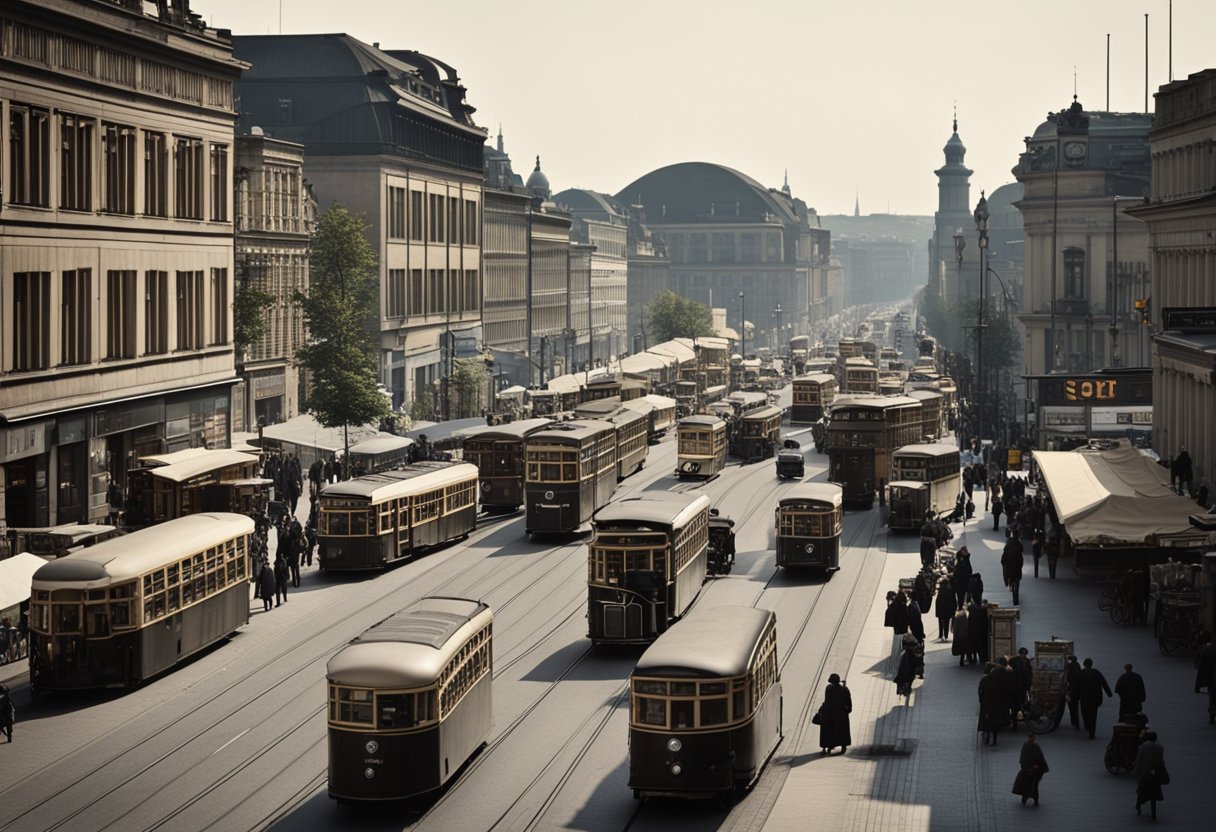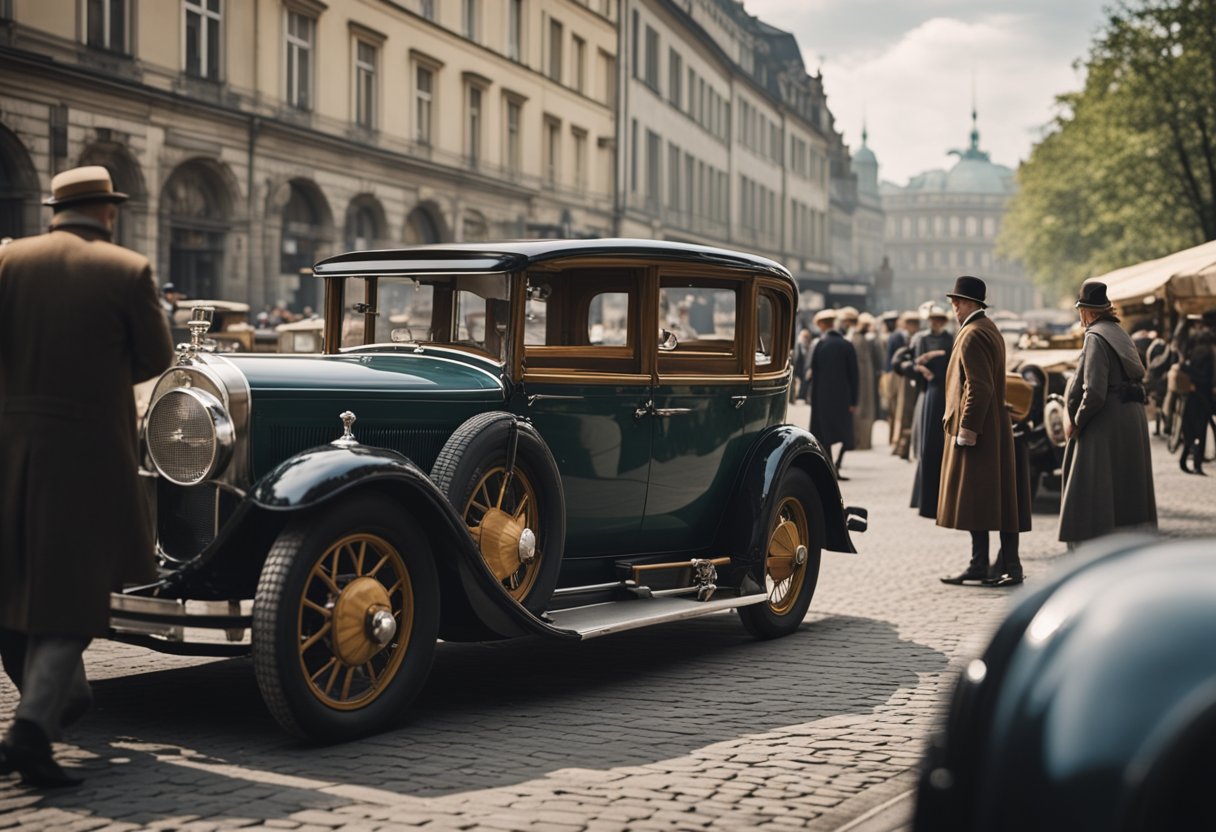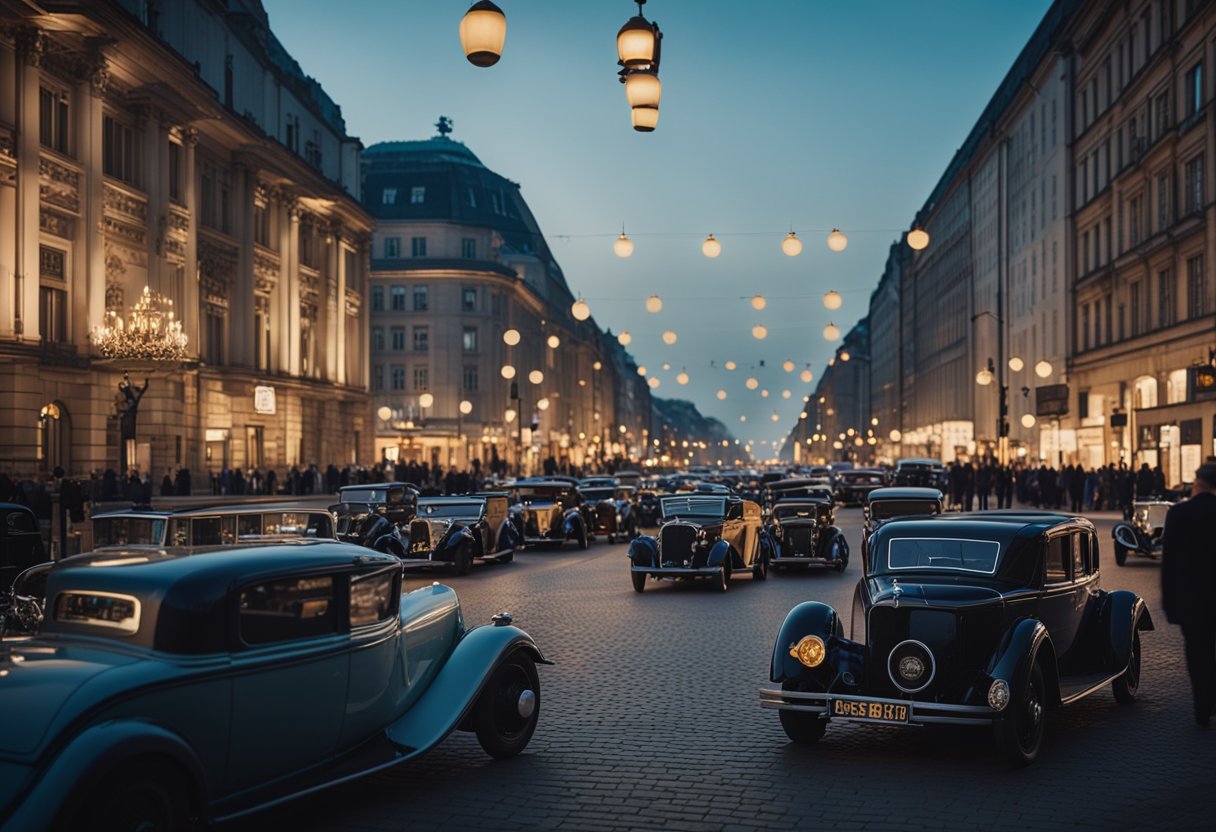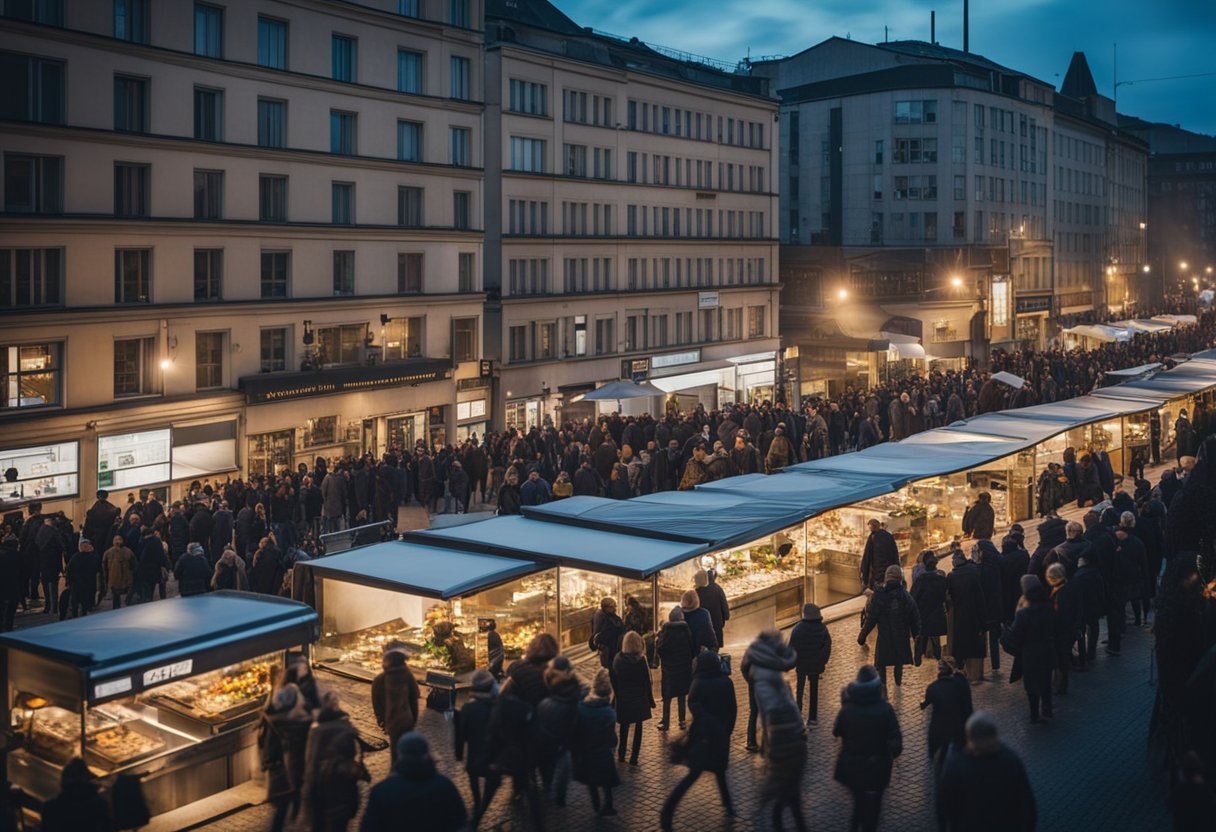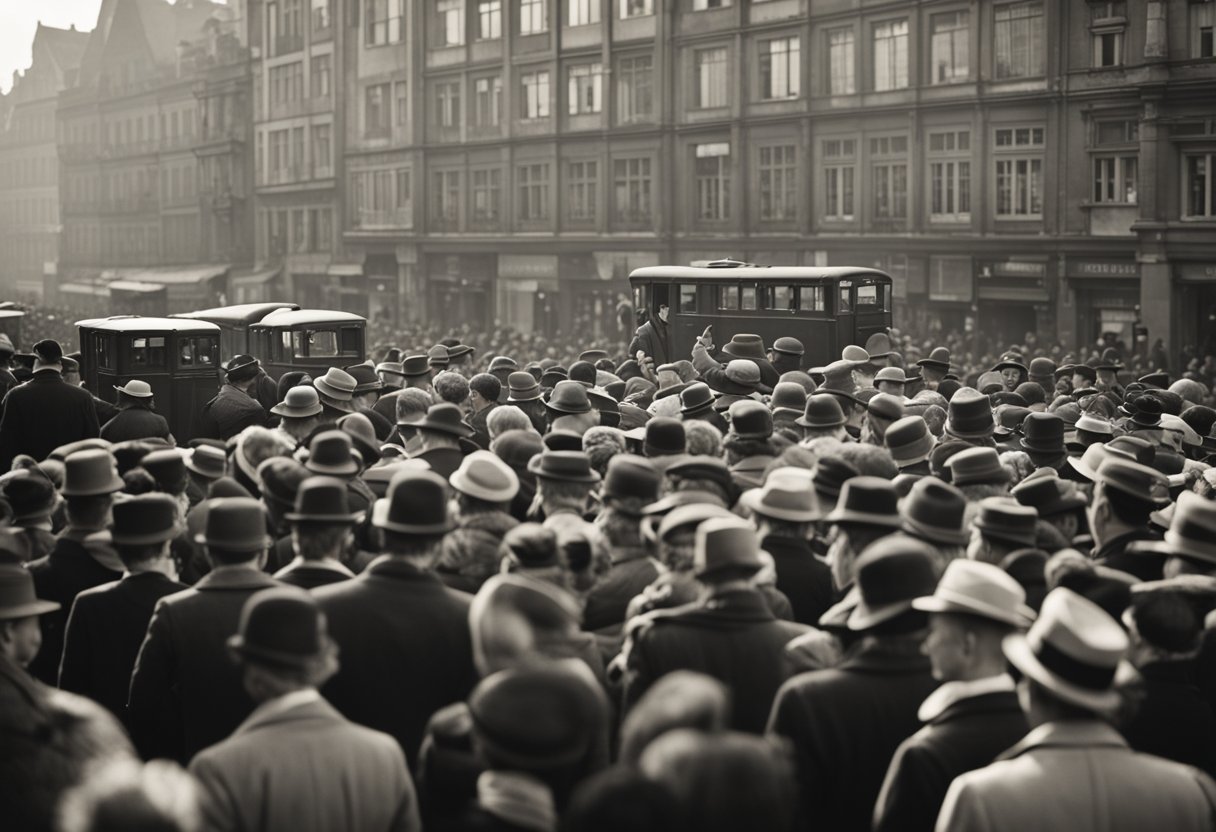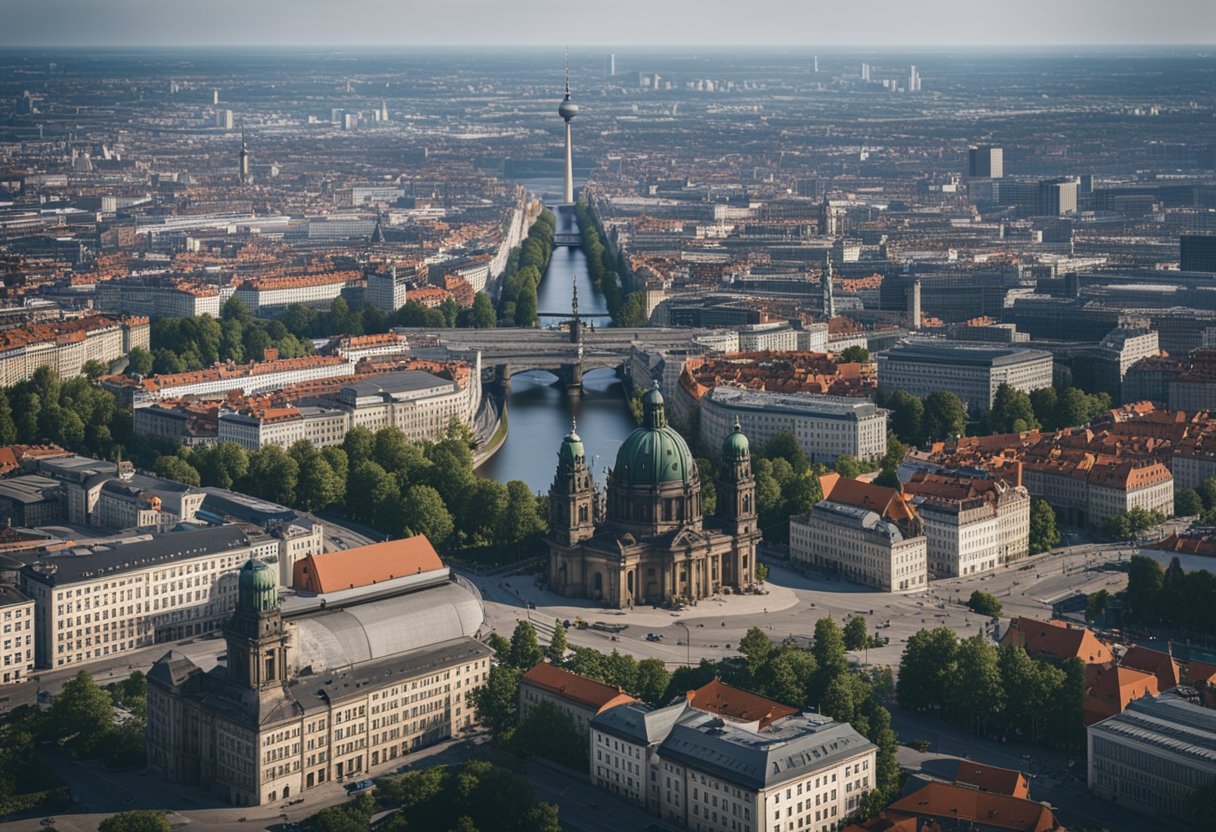Berlin Germany in 1929 stood at the precipice of significant historical shifts, encapsulating the twilight years of the Weimar Republic. In this period, the city was a vibrant center of culture, political thought, and groundbreaking art.
The spirit of 1929 saw Berlin bustling with innovation and creativity, exemplified by its thriving film and theater scenes, as well as its nightclubs and cabarets that pulsed with the Modernist beat.
However, the year was also marred by the global economic downturn triggered by the Wall Street Crash, which would drastically affect Germany and set the stage for political upheaval.
The prosperity that had been experienced during the ‘Golden Twenties’ began to falter, as foreign investments waned and unemployment soared.
Contrasts were stark within the city—while the intellectual elite enjoyed an unprecedented flourish in literature, science, and philosophy, social unrest grew among the working class, culminating in events such as Blutmai, where political tensions erupted into violence.
The city thus became a focal point of the political extremes that were vying for control in a fragile democracy.
Despite these challenges, Berlin continued to be a hub of progression and modernity. Many of the era’s most influential figures walked its streets, from filmmakers to philosophers, contributing to the rich tapestry of the city’s history.
Nevertheless, the shadow of the forthcoming decade loomed, with 1929 marking the beginning of a tumultuous chapter that would radically transform Germany and the world.
Historical Context-Berlin Germany in 1929
Berlin in 1929 was shaping into a city of stark contrasts, teeming with political unrest, soaring artistic exploration, and significant economic volatility.
The world watched as Germany grappled with its young democracy, the influence of foreign economics, and the cultural rise that defined and revolutionized the era.
Weimar Republic Overview
The Weimar Republic was Germany’s first foray into democracy post-World War I, spanning from 1919 to 1933.
Berlin served as the vibrant heart of this republic, witnessing frequent changes in government and the struggle to maintain a democratic foothold in a sea of political challenges.
Political Landscape
In 1929, Berlin’s political climate was marked by the growing tensions between factions. The Nazi Party was gathering strength under Adolf Hitler, while the Communist Party of Germany (KPD) and the Social Democrats (SPD) contended for support. The chancellor and government grappled with maintaining stability amid these rising extremist movements.
Economic Conditions
Germany, including Berlin, was severely impacted by post-war inflation, but the mid-1920s brought a period of relative prosperity.
This stability, however, was perilously reliant on American loans and investments, a vulnerability starkly revealed by the Wall Street Crash of 1929, which signaled the onset of the Great Depression across developed nations.
Art and Culture
The art and culture of Berlin Alexanderplatz and Babylon Berlin illustrate the flourishing cabaret scene, the provocative film industry, and breakthroughs in music and literature. Influential figures such as Christopher Isherwood and Alfred Döblin captured and contributed to the zeitgeist of this tumultuous yet vibrant epoch.
Influence of American Economics
The 1920s in Berlin were significantly shaped by American economic influence. The influx of American industrial production and investment from entities like the New York Stock Exchange propelled German industries.
However, this interdependence also meant that events like the Wall Street Crash would have dire ripple effects on the Weimar Republic and cities like Berlin.
Events of 1929
In 1929, Berlin was rocked by tumultuous events that reshaped its political and cultural landscape. The year saw an economic catastrophe of international proportions and significant local unrest, coupled with progressive strides in the realms of arts and entertainment.
The Wall Street Crash
On October 24th, 1929, a day known as Black Thursday, the share market on Wall Street plunged, precipitating a global economic downturn. This crash heavily affected Germany, leading to panic-selling, dwindling production figures, and a sharp decline in profits.
Foreign investment retreated rapidly, which contributed to the imposition of tariff barriers and strained the financial reserves of Berlin’s industrialists. This financial upheaval led to soaring unemployment and widespread economic distress within the city.
May Day Protests and Blutmai
From the 1st to 3rd of May 1929, Berlin became the epicenter of political violence, known as Blutmai, following the May Day protests. The Berlin police and the Social Democratic Party imposed a ban on public gatherings, a directive defied by the Communist Party of Germany (KPD) and its supporters.
The resulting confrontations between the Roter Frontkämpferbund, a paramilitary organization affiliated with the Communists, and the Sturmabteilung, associated with the Nazis, turned violent. Reports detailed numerous arrests, scores of injuries, and several deaths.
Artistic Developments
Despite the economic catastrophes and violent outbursts, Berlin’s cultural scene flourished in different areas such as film, music, literature, and cabaret.
The city was a hotspot for modern artistic expression, continuing to establish itself as a pivotal center for innovative and avant-garde art forms. This surge in creative undertakings provided a crucial escape for many from the grim reality of the societal upheavals they faced daily.
Social and Economic Impact
In 1929, Berlin faced unprecedented socioeconomic challenges following the Great Crash, with dire consequences spanning from rampant unemployment to sweeping political shifts and cultural upheaval.
Unemployment and Crisis
By the end of 1929, mass unemployment was a grim reality in Berlin. The runaway financial crisis meant that businesses, from large corporations to small enterprises, were left with no choice but to shut down or lay off a vast number of workers.
This created a spiral of unemployment that affected all strata of society, including white-collar workers who previously felt secure. The impact was severe with many facing malnutrition and an uptick in hunger-related diseases as living standards plummeted.
The Rise of Extremist Politics
The economic hardships facilitated a political environment ripe for extremist ideologies. The Nazi Party (NSDAP) and the Communists capitalized on the widespread discontent, blaming the Social Democrats and the government for the crisis.
Adolf Hitler and the NSDAP used propaganda to position themselves as the sole force capable of restoring Germany’s former glory, branding their rivals as proponents of social fascism. This period saw a staggering rise in support for the NSDAP as they promised to end the crisis and struggle of the proletariat.
Cultural Shifts
Amidst the chaos, Berlin’s cultural scene experienced significant shifts. Literature and music often reflected the tensions and disillusionment of the populace.
A certain liberalization of norms also took place, leading to an increase in prostitution and a nightlife often described in stark contrast to the struggles of daily life.
Interestingly, this period also witnessed unique contributions to art and music which incorporated both critique and escapism from the harsh social realities.
Reactions and Counteractions
Berlin in 1929 is emblematic of a society gripped by severe economic challenges and political unrest. The responses to these difficulties came from various sectors, including governmental entities, international agents, and diverse social and political movements, each with its own set of solutions to the myriad issues at hand.
Government Response
The government, led at different times by Chancellors Hermann Müller and later by Heinrich Brüning, grappled with the tasks of managing a burgeoning budget deficit and rising unemployment.
Policies such as wage cuts and spending reductions were introduced in an attempt to stabilize the economy, though they also contributed to public suffering and perpetuated government instability.
These measures often led to an escalation in violence as seen during events such as the Blutmai (Blood May), during which the Communist Party of Germany (KPD) clashed with the police.
International Response
Globally, the year 1929 is notoriously marked by the Wall Street Crash, which had a domino effect on economies worldwide, severely hitting Germany.
American banks called in their loans, which exacerbated Germany’s economic woes. This, coupled with rising tariff barriers, weakened international trade and frayed geopolitical relations.
Some countries responded with financial support mechanisms, yet the assistance was not always sufficient to curb the economic decline.
Social and Political Movements
Social and political movements in Berlin throughout this period were notably polarized. On one end, the Communists and Nazis capitalized on the chaos, rallying their paramilitary groups and agitating against the status quo.
Meanwhile, centrist and leftist groups struggled to address the grievances of the populace while maintaining order. This period saw the Nazis amass a significant following, driven largely by frustrations over unemployment and the perception that the Weimar Republic was failing to address the economic crisis adequately.
The strife on the streets of Berlin was a clear manifestation of broader societal conflict, with frequent outbursts of violence involving multiple political factions.
Infrastructure and Urban Development
In 1929, Berlin was rapidly evolving, with a focus on infrastructure and urban development that transformed the city into a modern metropolis. The Weimar Republic era brought significant changes in various sectors:
Industries:
- Became diverse, promoting economic growth
- Included manufacturing, film, and the arts
Tempelhof Airport:
- Symbol of avant-garde architecture
- Expanded to accommodate increasing air traffic
Transportation:
- Extensive public transit system development
- Trams and buses: Expanded to reach new areas
- U-Bahn (subway): Network growth facilitated urban connectivity
- Private car ownership increased, influencing city layout
Housing:
- Addressing population growth
- New housing projects implemented
- Aimed to alleviate overcrowding
- Focused on sanitation and amenity improvement
Urban Planning:
- Progressive urban planners sought to restructure the city
- Maximizing functionality
- Enhancing aesthetics
- Green spaces and thoroughfares became integral to designs
The era was marked by a keen attention to detail in integrating infrastructure with the urban environment of Berlin.
Each initiative reflected an ambition to shape a city that catered to industrial growth while maintaining social welfare. These developments in Berlin’s infrastructure and urban planning laid the foundation for the complex and multi-faceted cityscape known today.
Berlin’s Global Influence
In 1929, Berlin was emerging as a hub of cultural innovation and economic significance, attracting global attention through its artistic vibrancy and the burgeoning economic interactions facilitated by American loans and other financial mechanisms.
Cultural Exports and International Relations
Berlin’s cultural scene during the Weimar Republic was characterized by a prolific output in art, music, film, and literature.
Artists such as George Grosz and Otto Dix captured the zeitgeist in visually striking works, while the Universum Film AG (Ufa) studio led the way in the film industry, making classics like Fritz Lang’s Metropolis. Not only did these films showcase groundbreaking creativity, they also influenced interactions abroad.
Similarly, the music and nightlife, exemplified by the likes of Marlene Dietrich, played a crucial role in fostering Berlin’s image as a culturally affluent city on the international stage.
Economic Relations and Aid
Economically, Berlin acted as a key player through the intricate web of credit, savings, and profits. The adoption of the Dawes Plan in 1924 had stabilized the German economy with significant American loans, leading to an influx of capital which enabled the country, and particularly its capital, to enter into prosperous economic relations with other nations.
This period also saw growth in industry and commerce, establishing Berlin as an economic hub within Europe. The city’s financial institutions became central to Germany’s recovery, handling international transactions that contributed to a semblance of stability in a time of great economic flux.
Frequently Asked Questions
In 1929, Berlin experienced a tumultuous blend of political upheaval, socioeconomic challenges, and cultural innovation. This section explores the notable events and conditions that characterized Berlin in that year.
What significant events took place in Berlin in the year 1929?
Berlin was the scene of the Blutmai, or May Day Riots, prompted by the Communist Party’s defiance against a ban on public demonstrations, which led to violent clashes with the police. Additionally, the city felt the tremors of the Wall Street Crash, signaling the onset of economic destabilization.
How did the atmosphere of Berlin in the late 1920’s reflect the political and social climate of the time?
The late 1920s in Berlin were marked by a stark political division, with the rise of extremism on both the left and the right. The social atmosphere was charged with tension, reflecting the fight for control between political factions and the widespread dissatisfaction with the status quo.
What were the implications of the Operation Prangertag for Berlin in 1929?
Operation Prangertag was a police code name related to the crackdown against the Communist Party during the May Day Riots in Berlin. This aggressive response by the police resulted in numerous fatalities and was indicative of the broader political repressions imposed by authorities against perceived threats.
Can you describe the economic conditions of Berlin during 1929?
The economic condition of Berlin in 1929 was on the brink of collapse. The city was deeply affected by the Wall Street Crash of 1929 and the consequent withdrawal of foreign investments, which exacerbated the unemployment rate, reaching three million by the year’s end.
What were the causes and consequences of the Berlin riots in 1929?
The Berlin riots, or Blutmai, were caused by the Communist Party’s determination to assert their presence through May Day marches against a government-imposed ban. The consequences were severe, with over 30 fatalities, hundreds injured, and a subsequent crackdown on the Communist Party of Germany.
How did Berlin’s cultural scene evolve during the late 1920s?
In the late 1920s, Berlin was a hub for cultural experimentation and progress, especially amidst the avant-garde in cinema, theater, art, and architecture. Despite the political and economic uncertainties, the city fostered a vibrant and innovative cultural scene that contributed richly to what is known as the Golden Twenties.
